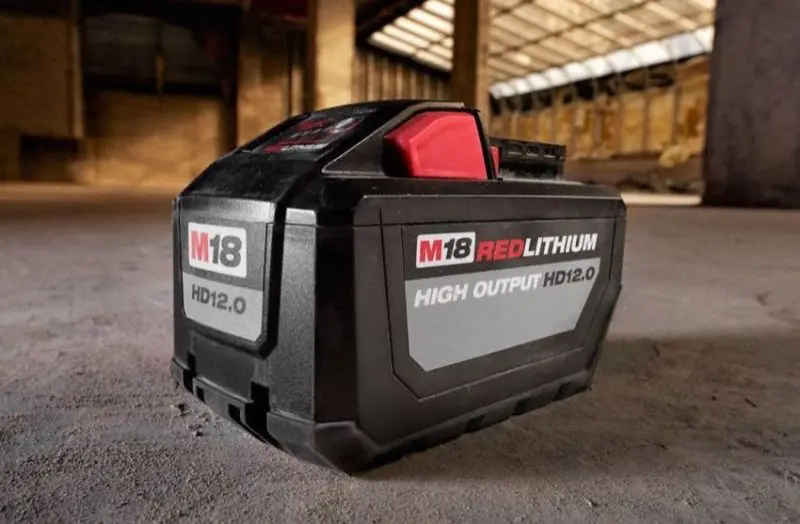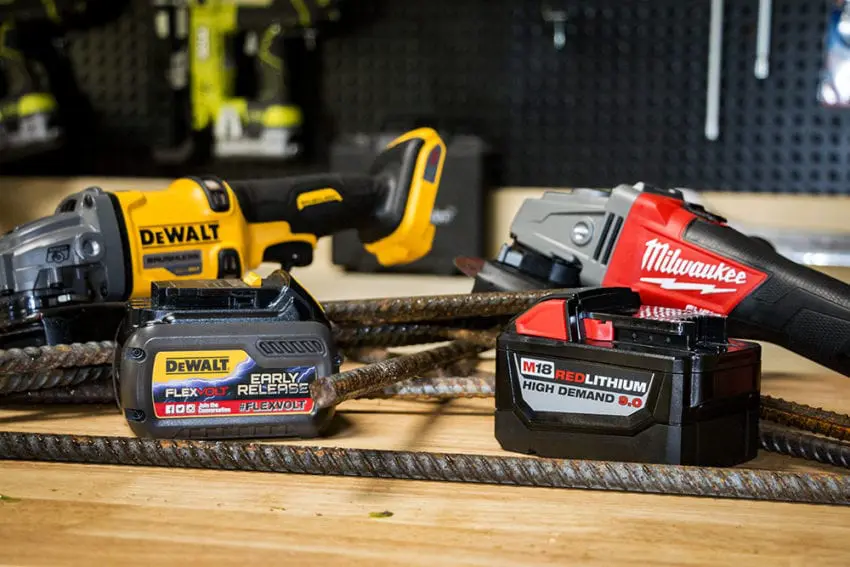Without a doubt, when it comes to comparing Milwaukee versus DeWalt, we can’t help but turn to the batteries each brand uses to run its core power tools. For Red and Yellow, it comes down to Milwaukee M18 RedLithium High Output batteries and DeWalt FlexVolt. It’s reignited the debate between the need for higher voltage and greater amp-hour capacity to extend runtime and power on the jobsite. When it comes to Milwaukee High Output vs DeWalt FlexVolt batteries, we had two ways to compare them. The first lined up the available batteries to compare capacities. The second involved testing them head-to-head.
Table of Contents
- DeWalt FlexVolt vs Milwaukee High Output Battery Capacities Compared
- Milwaukee High Output vs DeWalt FlexVolt Battery Capacity
- Milwaukee High Output vs DeWalt FlexVolt – Who Makes the Biggest Battery?
- Milwaukee High Output vs DeWalt FlexVolt Voltage vs Amp Hours
- Milwaukee High Output vs DeWalt FlexVolt – Testing the Packs
- Milwaukee High Output vs DeWalt FlexVolt Battery Results
- High Output vs FlexVolt Batteries Closing Thoughts
- The Bottom Line
DeWalt FlexVolt vs Milwaukee High Output Battery Capacities Compared
Keep in mind that with DeWalt Flexvolt, you have two ratings. When using a DeWalt FlexVolt battery with a 20V tool, you have a higher Ah rating. When using it with a 60V FlexVolt tool, the lower rating takes over. The packs don’t change in terms of capacity—just how we refer to them when testing apples-to-apples:
- FlexVolt 60V/2Ah = 20V/6Ah
- FlexVolt 60V/3Ah = 20V/9Ah
- DeWalt FlexVolt 60V/4Ah = 20V/12Ah
- DeWalt FlexVolt 60V/5Ah = 20V/15Ah
Here’s how the Milwaukee High Output and DeWalt FlexVolt battery packs match up. Keep in mind we’re only comparing 60V FlexVolt-specific packs on the DeWalt side:
| Milwaukee M18 | DeWalt FlexVolt (60V) |
|---|---|
| CP3.0 High Output | no comparable pack |
| XC6.0 High Output | FlexVolt 6Ah |
| XC8.0 High Output | FlexVolt 9Ah |
| HD12.0 High Output | DeWalt FlexVolt 12Ah |
| no comparable pack | DeWalt FlexVolt 15Ah |
Milwaukee High Output vs DeWalt FlexVolt Battery Capacity
For an easy visual comparison, we grabbed a Milwaukee M18 RedLithium High Output HD12.0 battery pack and a DeWalt FlexVolt 4.0Ah (20V/12Ah) battery. While DeWalt also has a 5Ah (20V/15Ah) FlexVolt battery, the size makes it impractical for many handheld power tools.
Going by the above chart, the Milwaukee High Output 12Ah M18 RedLithium battery extends capacity while staying on its original 18V platform. A simple multiplication problem of nominal volts multiplied by the amp hours yields a total capacity of 216 watt-hours packed into 15 lithium-ion cells. You can find the total Watt-hours written on the underside of nearly any battery pack.

DeWalt FlexVolt batteries have the ability to switch between 20V Max and 60V Max voltages. These are maximum voltages at the highest charge state and translate to 18V and 54V nominal. At 20V, if a FlexVolt battery has 12.0 amp-hours, and it has 4.0 amp-hours running at 60V.
DeWalt and Metabo HPT MultiVolt have the only batteries on the market from major tool manufacturers with the ability to switch voltages. This makes both DeWalt FlexVolt and Metabo HPT MultiVolt batteries truly unique.
Milwaukee High Output vs DeWalt FlexVolt – Who Makes the Biggest Battery?
OK, so when considering the Milwaukee High Output vs DeWalt FlexVolt, who makes the biggest battery? While Milwaukee tops out at 12Ah, Dewalt has a 15Ah FlexVolt battery pack. Multiply the nominal voltage times the amp-hour capacity, and you’ll find the DeWalt 15Ah monster battery has 270 nominal watt hours. It derives that power and capacity from 30 individual 18650 lithium-ion cells. That provides more capacity than the 216Wh found on Milwaukee’s current flagship 12Ah battery pack.

So when we look at the battery capacity in terms of watt-hours (total power availability), we see that DeWalt FlexVolt currently has a clear advantage over Milwaukee High Output. However, Milwaukee and DeWalt come evenly matched when it comes to batteries you’re likely to stick on a handheld tool like an impact driver, drill, or angle grinder.
Milwaukee High Output vs DeWalt FlexVolt Voltage vs Amp Hours
There’s a complex debate between voltage and amp hours that involves a lot of physics and chemistry geek speak. We’re not going to get into all of that right now, but the bottom line is that you have to have both to produce power. Increasing either the voltage or the current flow will increase your available power. Let’s look at this simple equation:
Power = Current x Voltage
To get the same power you can either increase current…or increase voltage. Take your pick. In this way, the higher voltage does not necessarily equate to a higher power tool. That’s especially true given the limitations of a battery pack’s total capacity (measured in watt-hours (Wh). The Milwaukee HD vs DeWalt FlexVolt batteries come pretty evenly matched.
| Battery | Model | Voltage | Amp-hours | Watt-hours |
|---|---|---|---|---|
| Milwaukee CP3.0 | 48-11-1835 | 18V | 3.0Ah | 54Wh |
| Milwaukee XC6.0 | 48-11-1865 | 18V | 6.0Ah | 108Wh |
| DeWalt FlexVolt 6.0Ah | DCB606 | 20V/60V | 6.0Ah/2.0Ah | 108Wh |
| Milwaukee XC8.0 | 48-11-1880 | 18V | 8.0Ah | 144Wh |
| Milwaukee HD9.0 | 48-11-1890 | 18V | 9.0Ah | 162Wh |
| DeWalt FlexVolt 9.0Ah | DCB609 | 20V/60V | 9.0/3.0Ah | 162Wh |
| Milwaukee HD12.0 | 48-11-1812 | 18V | 12.0Ah | 216Wh |
| DeWalt FlexVolt 12.0Ah | DCB612 | 20V/60V | 12.0/4.0Ah | 216Wh |
| DeWalt FlexVolt 15.0Ah | DCB615 | 20V/60V | 15.0/5.0Ah | 270Wh |
Plugging in the Numbers
In theory, if you give two tools identical tasks it should require the same amount of work from both regardless of the volt/amp configuration. So let’s plug in some actual numbers for these batteries:
Milwaukee HD12.0 Pack Power = 12.0 Ah x 18V = 216 Wh
DeWalt FlexVolt 12.0 Ah Power = 4.0 Ah x 54V (nominal) = 216 Wh
or using the battery in series mode at 20V Max…
DeWalt FlexVolt 12.0 Ah Power = 12.0 Ah x 18V (nominal) = 216 Wh
The reality is you can only go so far before putting the cells in danger, usually due to heat. So is one battery better than the other in this case?
That’s exactly what we wanted to know. To compare the Milwaukee High Output vs DeWalt FlexVolt battery in a real-world scenario, we grabbed a couple of packs and started testing!
Milwaukee High Output vs DeWalt FlexVolt – Testing the Packs
We took the DeWalt FlexVolt angle grinder and Milwaukee M18 Fuel angle grinder and installed identical Diablo 5-inch cutting wheels. We wanted to see how many cuts we could make through rebar with a fully charged battery.


There are several ways to tackle this test, but we wanted to mimic what users in the field would most likely experience. We chose to dial in the sweet spot between cutting speed and battery efficiency. That meant cutting through the rebar as quickly as possible without bogging down the tool in the process.
We switched grinders after every cut and ensured each had a minimum of 30 seconds of rest before cutting again.
Milwaukee High Output vs DeWalt FlexVolt Battery Results
The DeWalt FlexVolt Grinder clearly exhibited more power than the Milwaukee. It showed quickly in testing. We found we could cut efficiently with roughly a 2-second advantage on average. That varied as the cutting wheel wore down, however. The average cut for the DeWalt FlexVolt took about 17 seconds with the Milwaukee falling right at 19 seconds. There were both faster and much slower cuts for each throughout the test.
At no time did either grinder give up due to heat build-up. Also, neither tool (nor its battery) felt so hot to the touch that appeared to be in danger of shutting down.
After running the Milwaukee High Output vs DeWalt FlexVolt comparison, the FlexVolt grinder finally gave up after 50 cuts. Milwaukee’s Fuel grinder lasted through 68. Keep in mind that you might get different results using different battery packs. On top of that, the tool can certainly affect the results more than the battery.
Evaluating the Results
So does greater battery capacity result in more cuts? Yes…sometimes.
The power of DeWalt’s 60V Max grinder clearly had something to do with our results. Since it didn’t have to work as long as the Milwaukee to make each cut, it finished the job more quickly. When you look at the total time each grinder had to work, it became more clear. DeWalt had to work for roughly 14 minutes, 10 seconds. Milwaukee worked 21 minutes, 30 seconds—52% longer than DeWalt.
Milwaukee and DeWalt also offer multiple models of grinders—so your results should vary depending on which tool you operate.
The X-factor in all this is that a Milwaukee High Output battery of higher Watt-hours could be much more efficient vs a smaller DeWalt FlexVolt pack when using something like a cutting wheel. The same goes for the reverse.
In our testing, we switched out the wheels after 30 cuts when getting close to the end of their useful life (but before it was completely exhausted).


High Output vs FlexVolt Batteries Closing Thoughts
Both Milwaukee and DeWalt have very valid claims you need to seriously consider in your purchasing decision. First, DeWalt has clearly raised the bar on how much power they’re getting from many of the new tools in the FlexVolt line. The batteries are backward compatible with your DeWalt 20V Max products. They also have a 162 watt-hour battery on deck. You can’t, however, use your 20V Max batteries in a FlexVolt tool, so you are getting into a new battery and tool system.
For now, DeWalt undeniably has higher battery capacity and run-time with their 15Ah pack. The practical use of that battery, however, remains with larger tools and equipment.
Meanwhile, with Milwaukee, you don’t have to buy into a new battery platform in order to use all your M18 tools. They certainly deliver a lot of power on their 18-volt grinder, but that particular grinder was exceeded handily by the DeWalt FlexVolt tool in our testing. As lithium-ion battery technology continues to improve, all of these power concerns should go away altogether.
The Bottom Line
This is just one test among hundreds that we could have chosen from across several different tools. Every user’s needs are going to be a little bit different, so you need to take the information you’ve learned here, and decide for yourself if one battery platform is better for you than the other.
There are a lot of variables in play thanks to the wide variety of tools that are powered by both batteries. At the end of the day, if staying on one battery platform and knowing all your tools will work with all your batteries is most important to you, Milwaukee is the way to go. They also have more available models and sizes.
But then there’s the Metabo 36V 9-inch grinder… A conversation for another day perhaps.
Tell us what you think! Sound off on Facebook, Twitter, and Instagram!





